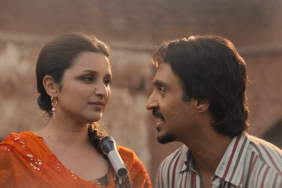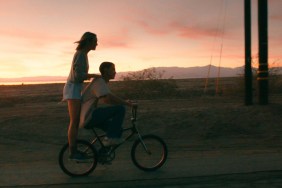García’s new movie Mother and Child seems to be solidifying García’s position as the Latin Tyler Perry, not so much in terms of wealth or being insanely prolific as much as his ability to make movies centering on believable women characters and getting to the heart of what makes them tick. In this case, it’s three very different women dealing with different aspects of the adoption process. Annette Bening’s Karen gave up her child for adoption over thirty years prior, something she never quite overcame, while Naomi Watts plays that daughter Elizabeth, who has grown up into a fiercely independent woman without ever having known her mother. When she suddenly finds herself pregnant, she insists on not repeating her mother’s mistake. Completely apart from those two women is Kerry Washington’s Lucy, a woman desperate to have a child but unable to conceive one herself, so she’s been attempting to adopt.
Around these women and the difficult decisions they face are a number of influential male forces like Lucy’s disapproving husband and the more supportive men hoping to be there for Karen and Elizabeth, played by Jimmy Smits and Samuel L. Jackson respectively. When it comes to character-driven drama, there are few filmmakers who can keep you as riveted to every character’s words and actions as well as García does in what’s potentially one of the better movies of the year.
Not surprisingly, Mother and Child was also one of the standouts at last year’s Toronto International Film Festival, which is where ComingSoon.net had a chance to sit down with García to talk about the movie.
ComingSoon.net: Prior to this, you directed a segment in the triptych “Fathers and Sons,” and this is almost the polar opposite to that in some ways. At what point did you say, “I want to explore the subject of adoption”?
Rodrigo García: This is actually a much older project than even “Fathers and Sons.” I started writing this about ten years ago. I don’t know, it’s not based on anything, this idea. My children were little at the time and this idea (about) just feeling that bond with a baby that can be so strong, in fact, it can feel brutal and scary. It’s not far from there to think, “Well, what about those people who are separated from their babies, people who are separated from a child?” That’s how the idea was born about a woman who had – I don’t want to say “given up a baby” because I wanted her to be young enough that it wasn’t really her choice, that probably at fourteen her mother’s pressure would’ve ruled so that she had given up the baby unwillingly – and how the two of them had spent their lives thinking about each other and sometimes not even admitting to themselves that they longed for the other.
CS: What’s interesting to me is that it’s something that she doesn’t even address until much later in the movie, which I found interesting – that they don’t really speak about it much even though it’s such a huge aspect of their personality. Why did you make that decision?
García: You know, I think some people don’t. I think the stuff that interests me. I’ve seen that where people live under the same roof, and there are just subjects that are never… a two-minute conversation could clear the air and often that two-minute conversation is never had. Karen probably lived much of her life scared about her mother, and it was her mother who was scared of her because she’s such a forceful individual. So I liked that idea, that sometimes two minutes can clear the air. In fact, I think that’s what happens to Karen. She’s stepped into a room and the housekeeper told her everything that was going on in her own household.
CS: When you wrote this, did you talk to any women who had given up their babies?
García: I did. I mean, I talked to a few women who had been adopted, a different situation than Elizabeth because many of these women had very happy adoptive families and had had very happy adopted lives. So I spoke mostly to women who had been adopted, none of them of course anything like Elizabeth, and a couple of women who had relinquished babies, but not people who had done it at fourteen. So, I did read up a lot. I mean, obviously there’s a lot of accounts and diaries and studies on the subject of women who have relinquished babies.

CS: Do you yourself have a family with a lot of women, like having a lot of sisters?
García: No, I have one brother.
CS: It’s interesting because you have a Latin background and there are certain characteristics expected of the men, yet there are filmmakers like Pedro Almodovar, who can get past that in order to deal with women’s issues. You don’t see that often though.
García: I mean, there are a lot of male directors around the world who have made movies about women, many great directors, but yeah, I suppose it’s quite common in Latin America. I can’t explain why I’m interested in it.
CS: You’ve always gotten these great performances out of actresses, and I’m sure “Nine Lives” is a great calling card in that sense.
García: Yeah, I think actors always want to know who else is involved, who else has worked with you, so it certainly has helped in this.
CS: What was involved with getting Annette and Naomi on board? I know that Naomi had already worked with your producer Alejandro, but what about Annette?
García: Obviously, she was one of the first people we thought of to play Karen. I thought she’s obviously a great actor and someone who could really reflect out Karen. We initially went after her, but because of some personal commitments, she unfortunately could not do the movie and that was a disappointment. But ultimately we were delayed and money fell through, etc., so we ended up coming back to her and she did it, which I think was very fortunate.
CS: What kind of concerns did she and Naomi have about their characters and how harsh to play them without worrying about pushing the audience away with some of the things they do early in the movie?
García: Yeah, I think that they were concerned. I mean, I think that’s the challenge is to have people who behave outrageously, but to find the why of it and try to understand and portray that it comes from a place of pain, not from a place of just wanting to be destructive. So, no, they both took to their characters immediately.
CS: Also, the men in this movie are very sensitive, very caring…
García: Well, we have the neighbor… Elizabeth’s neighbor is not. Yeah, but I always though that Elizabeth and Karen in different times in their lives both ran into men that were good men. These are two women who are very closed off and very controlling and not open to life and to feel things. I think Karen, despite all her emotional obstacles, was able to change and open up and accept Paco whereas I think Elizabeth was not ready to embrace Paul. I think they both had the good fortune to meet good men, but one of them was more open to it than the other.
CS: How do you approach a project like this different than “Nine Lives” which was separate stories that eventually come together? Here you have three completely separate stories for the most part, so did you try to one of them first before the others?
García: We did it all in whatever way we could. It scheduled around actors’ availabilities, scheduled to maximize the budget. I always thought of it as the one movie. I mean, it is told in these three strands. It really is shot in whatever is the most practical way. We didn’t think of it or schedule it as three stories.

CS: There are movies like this where you have separate stories but then the characters are always bumping into each other, so was there any temptation to get them together sooner?
García: Well, I mean, I couldn’t do it sooner because I always knew what the end was. I always knew how the three strands came together, so if I’d done it sooner, it would’ve been different.
CS: It does work, it’s just surprising. Did all three actors know what was going on in the other stories or did you generally keep them focused on their own separate strand?
García: No, I think while we’re shooting each one of them is very much in her own world and in her own head. There’s that curiosity and they ask about how the other story’s going, but it’s hard work to play one of these roles and I think we were shooting very quickly, so I think each actor was fully submerged in her thing.
CS: You also did a lot of interesting camera stuff in “Nine Lives” such as doing one-take one-shot scenes and that sort of thing, but you seemed to shy away from that this time.
García: Yeah, I mean, I’m not a particular fan of… I mean, it depends on what the movie is. “Nine Lives” was just ten, twelve minutes in the life of a person and I thought it would be interesting to do them in continuous shots, so we did that with a steadicam and it’s moving around and there are no cuts, but I thought this movie was different. It’s a movie of shorter, quieter moments mostly, so we shot it very traditionally.
CS: Did you have a lot of rehearsal to work with each of the different actors or do you generally avoid that so you can capture as much of those performances on camera?
García: Yeah, we had a script read-through of each one of the sections. Three times we got together with the actors in each section and had a read-through just to open up the conversation and questions if there are questions. But there is really no significant rehearsal period; I try to keep it as fresh as possible.
CS: You mentioned before about financing. Drama in general is a tough sell. There are people who enjoy these movies and love the genre, but it’s a hard-sell to people at studios. Did you find that was the case with this?
García: Yeah, I mean, this kind of movie’s always hard to finance even when the script has a good reception or it’s respected or even admired and even if you have good actors, distributors consider these movies risky. So, although they’re interested, they prefer that you’d find your own independent financing and then they can see the finished movie.
CS: Were you happy doing it that way, that being the case?
García: Well, obviously I’d rather go into it having a distributor so that you’re not… there’s always some uncertainty with the distribution. But doing it independently of course gives you much more creative freedom.
CS: This has a lot of difficult material in there but there are also some lighter moments where it gets laughs. Some of them are intentional, some are not, but it actually works well in that sense, so I was curious what you thought about the reaction the movie’s received so far.
García: Well, I think some of these women’s behavior, it really comes from a place of great tension from them, but I think people find that amusing, they find the outrageous behavior funny. I mean, it can be dreadful, but it’s also funny and I’m thankful for that. I think laughs always buy you a lot. If you bank some laughs, then people are okay when stories take darker turns.

CS: I really liked the cast you brought together besides the leads. I mean, you have Elizabeth Peña playing a very small role.
García: I think again, the question of who else in it. Once you get people like Naomi and Annette involved, people want to be a part of it in some capacity, even actors like Jimmy (Smits) and Sam (Jackson), in good roles I hope, but supporting roles, I think they’re working with Naomi, they’re working with Annette. Actors like that challenge and the security and the thrill of working with who they know is a good actor.
CS: Was Sam happy to be playing against type?
García: I think so. I mean, he read the script and we immediately got word that he wanted to be in it. I think he’s played many larger than life characters, and I’d like to think that he enjoyed playing this man who’s very mature and sensitive and a real guy, but also a regular guy who knows the score and has, I think, a lovely but short relationship with this woman.
CS: What would you like men to get out of this movie? You expect that they’ll be brought to see it by girlfriends, wives or maybe they’ll wander in just because they’re curious…
García: I don’t really think of it as a movie for women. I mean, I think it is a movie about women’s characters that hopefully it’s a movie about attachments and the difficulty of sometimes dealing with your feelings and opening up. So, I hope men will find it interesting.
CS: Do you feel that with the movies you’ve done so far, someone could put together a box set and there will be a very distinct throughline that people will see as your own?
García: I think that yes, they do share that they’re about women’s quests and women’s feelings and the desire to resolve relationships and not to be trapped in relationships. So yes, I think in that sense, “Things You Can Tell Just by Looking at Her” and “Nine Lives” and “Mother and Child,” they’re all part and parcel.
CS: Do you have any idea what you’re gonna do next? Are you going to continue doing writing and directing for yourself?
García: It’s so hard to make movies. You have to keep the flame burning in all… television, movies that I’ve written, movies that I’m writing, movies that are looking for a director. Obviously there’s a special place in my heart for a movie that I wrote myself, but yeah, whatever. If any story captures me, I’ll do it whether I wrote it or not.
Mother and Child opens in New York and Los Angeles on Friday.









